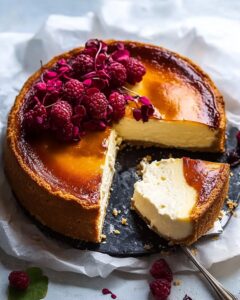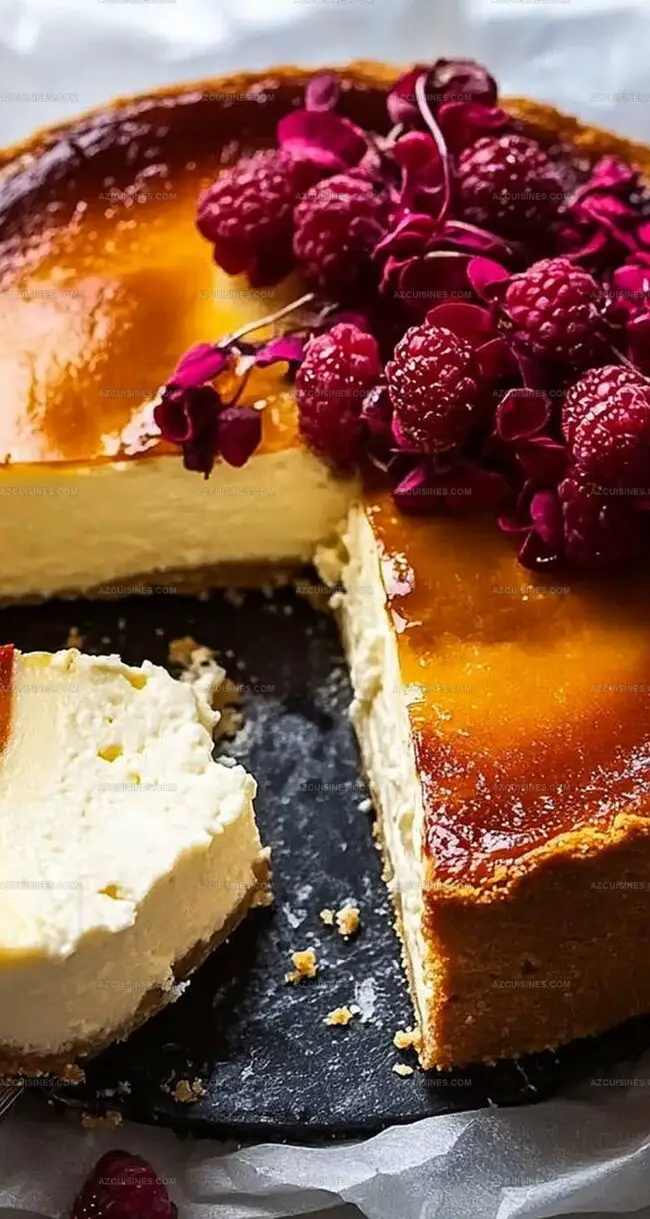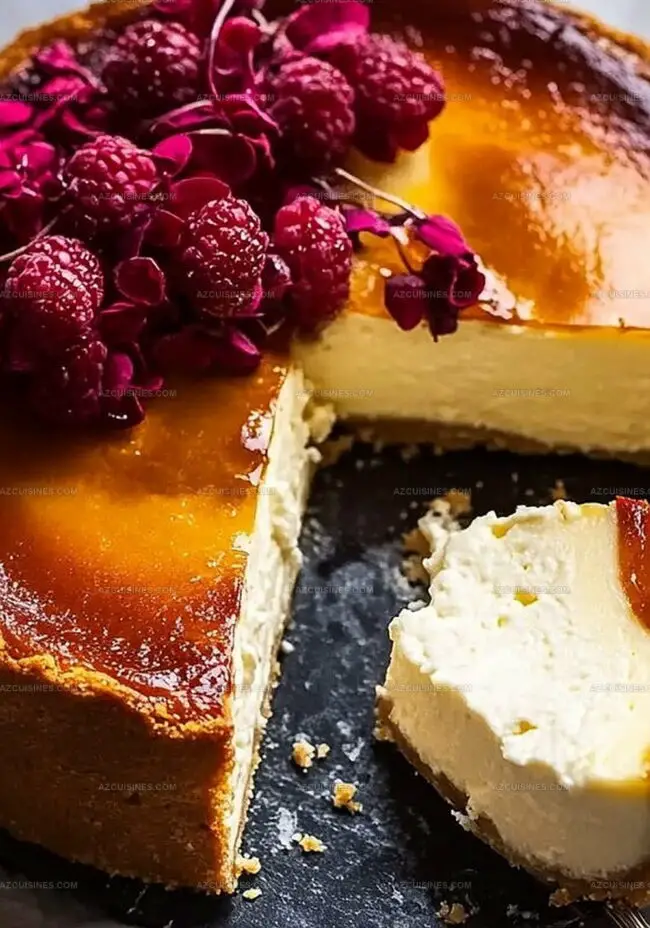The Silky Basque Burnt Cheesecake Recipe Everyone Adores
Whipping up a basque burnt cheesecake promises pure culinary magic that defies traditional dessert expectations.
Creamy textures contrast beautifully with caramelized edges in this rustic Spanish delight.
Celebrated for its intentionally cracked surface and dark golden exterior, this cake breaks all classic cheesecake rules.
Professional pastry chefs adore its elegant simplicity and dramatic presentation.
Minimal ingredients create maximum flavor impact with just a few precise techniques.
Home bakers can nail this recipe by following careful steps and embracing imperfection.
Prepare to savor a dessert that looks stunning and tastes even more incredible.
Why Basque Burnt Cheesecake Stands Out
What You Need To Make Basque Burnt Cheesecake
Main Ingredients:Dairy Components:Dry Ingredients:How To Bake Basque Burnt Cheesecake
Step 1: Prep the Baking Space
Warm up your oven to 400°F. Grab a 9-inch springform pan and create a parchment paper fortress that generously hangs over the sides.
The paper should look wrinkly and uneven – this isn’t about perfection.
Step 2: Whip the Cream Cheese Base
Grab your mixing bowl and transform cream cheese and sugar into a silky smooth landscape.
Beat them together until they’re completely integrated and looking dreamy.
Step 3: Incorporate Eggs
Drop eggs into the mixture one by one, giving each a serious beating.
Make sure each egg becomes best friends with the cream cheese before adding the next.
Step 4: Add Luxurious Liquids
Pour in:Blend everything until the mixture looks consistently gorgeous and inviting.
Step 5: Introduce the Flour
Softly sift flour into the batter. Fold gently – you want to whisper the flour in, not attack it.
Mix just until everything looks harmonious.
Step 6: Fill the Pan
Transfer the batter into your parchment-lined pan.
Spread it evenly with a calm, confident motion.
Step 7: Bake to Perfection
Slide the pan into the oven.
Bake for 50-60 minutes until the top looks dramatically caramelized and dark. The center should still have a playful jiggle when you nudge the pan.
Step 8: Cool and Chill
Let the cheesecake cool completely at room temperature. Then park it in the refrigerator for at least 4 hours or ideally overnight.
This waiting game develops incredible flavor.
Burnt Beauty Tips for Basque Cheesecake Success
Sweet Twists on Basque Burnt Cheesecake
Sips and Sweets with Basque Burnt Cheesecake
Keeping Basque Burnt Cheesecake Fresh and Dreamy
All Your Basque Burnt Cheesecake Questions, Answered
Unlike classic cheesecake, this version has an intentionally burnt, dark exterior with a soft, custardy center, giving it a rustic and unique appearance.
Not at all! It’s actually one of the easiest cheesecakes to prepare, with no need for a water bath or precise temperature control, making it perfect for beginner bakers.
The high heat creates the signature dark, caramelized top and helps achieve the distinctive burnt edges while keeping the center creamy and soft.
Print
Basque Burnt Cheesecake Recipe
- Total Time: 4 hours 70-80 minutes (including cooling and chilling)
- Yield: 8 1x
Description
Creamy Basque burnt cheesecake delivers a delightful twist on classic desserts with its caramelized exterior and silky smooth interior. Rich Spanish-style indulgence promises a melt-in-mouth experience you’ll savor down to the last crumbly bite.
Ingredients
Dairy:
- 500 grams (17.6 ounces) cream cheese, room temperature
- 1 1/4 cups (300 milliliters) heavy cream
- 1/2 teaspoon salt
Eggs and Sweeteners:
- 4 large eggs
- 1 cup (200 grams) sugar
Dry Ingredients:
- 1/4 cup (30 grams) all-purpose flour, sifted
- 1 teaspoon vanilla extract
Instructions
- Preheat oven to 400°F (200°C) and prepare a 9-inch springform pan by lining it with parchment paper, ensuring the paper extends generously beyond the pan’s edges.
- Using an electric mixer, cream the cream cheese and sugar until achieving a silky, uniform consistency with no lumps.
- Incorporate eggs individually, thoroughly blending after each addition to maintain a smooth texture.
- Gently introduce heavy cream, vanilla extract, and salt, mixing until the mixture becomes homogeneous.
- Sift flour directly into the batter, carefully folding until just integrated, avoiding overmixing.
- Transfer the batter into the prepared pan, using a spatula to distribute evenly and eliminate air pockets.
- Position the pan in the preheated oven and bake for 50-60 minutes, watching for a deep golden-brown top with a distinctly wobbly center when gently shaken.
- Remove from oven and allow the cheesecake to cool completely at room temperature, preserving its signature rustic appearance.
- Refrigerate for a minimum of 4 hours or overnight to achieve optimal setting and flavor development.
Notes
- Ensure cream cheese is at room temperature for smooth, lump-free mixing that creates a silky texture.
- Use parchment paper with generous overhang to help create the signature rustic, cracked top and easy removal.
- Avoid overmixing the batter to prevent incorporating too much air, which can cause cracking during baking.
- For a gluten-free version, replace wheat flour with almond flour or cornstarch to maintain the cake’s structural integrity.
- Prep Time: 20 minutes
- Cook Time: 50-60 minutes
- Category: Desserts
- Method: Baking
- Cuisine: Basque
Nutrition
- Serving Size: 8
- Calories: 415
- Sugar: 25g
- Sodium: 160mg
- Fat: 34g
- Saturated Fat: 21g
- Unsaturated Fat: 10g
- Trans Fat: 0g
- Carbohydrates: 28g
- Fiber: 0g
- Protein: 6g
- Cholesterol: 143mg




Truc Tran (Kris)
Senior Food Editor
Expertise
Home Cooking, Meal Planning, Recipe Development, Baking and Pastry, Food Editor, Cooking-video Maker, Vietnamese Food Evaluation Expert
Education
Truc Tran (Kris), an experienced food writer and editor, is great at exploring and describing global cuisines, from simple street food to fancy dining. In her writing, she skillfully mixes different flavors, cooking methods, and culinary traditions, showing the unique character of various cultures through their food and drinks. On azcuisines.com, Kris highlights her knowledge, especially in Asian cuisine and worldwide traditional dishes.